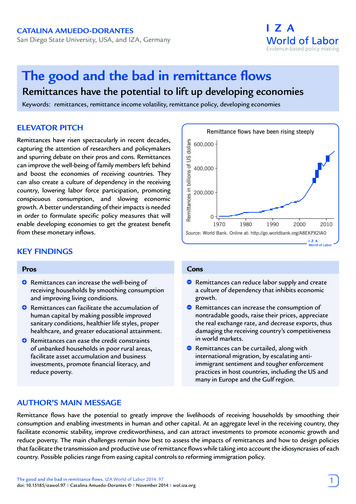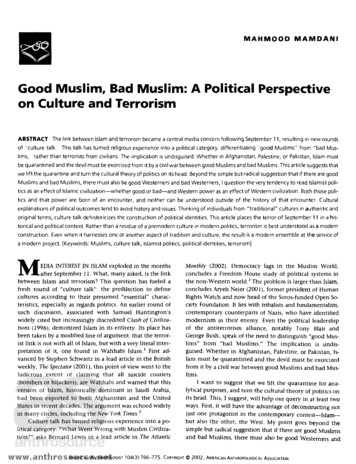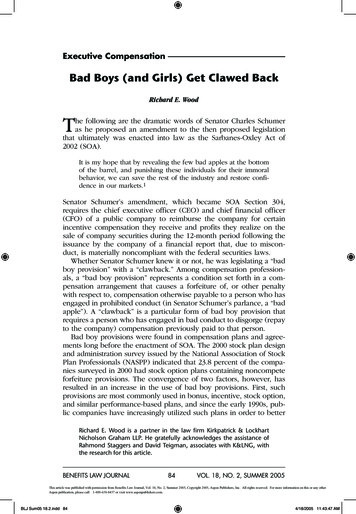
Transcription
Catalina Amuedo-DorantesSan Diego State University, USA, and IZA, GermanyThe good and the bad in remittance flowsRemittances have the potential to lift up developing economiesKeywords: remittances, remittance income volatility, remittance policy, developing economiesELEVATOR PITCHRemittances in billions of US dollarsRemittances have risen spectacularly in recent decades,capturing the attention of researchers and policymakersand spurring debate on their pros and cons. Remittancescan improve the well-being of family members left behindand boost the economies of receiving countries. Theycan also create a culture of dependency in the receivingcountry, lowering labor force participation, promotingconspicuous consumption, and slowing economicgrowth. A better understanding of their impacts is neededin order to formulate specific policy measures that willenable developing economies to get the greatest benefitfrom these monetary inflows.Remittance flows have been rising ource: World Bank. Online at: http://go.worldbank.org/A8EKPX2IA0KEY FINDINGSProsRemittances can increase the well-being ofreceiving households by smoothing consumptionand improving living conditions.Remittances can facilitate the accumulation ofhuman capital by making possible improvedsanitary conditions, healthier life styles, properhealthcare, and greater educational attainment.Remittances can ease the credit constraintsof unbanked households in poor rural areas,facilitate asset accumulation and businessinvestments, promote financial literacy, andreduce poverty.ConsRemittances can reduce labor supply and createa culture of dependency that inhibits economicgrowth.Remittances can increase the consumption ofnontradable goods, raise their prices, appreciatethe real exchange rate, and decrease exports, thusdamaging the receiving country’s competitivenessin world markets.Remittances can be curtailed, along withinternational migration, by escalating antiimmigrant sentiment and tougher enforcementpractices in host countries, including the US andmany in Europe and the Gulf region.AUTHOR’S MAIN MESSAGERemittance flows have the potential to greatly improve the livelihoods of receiving households by smoothing theirconsumption and enabling investments in human and other capital. At an aggregate level in the receiving country, theyfacilitate economic stability, improve creditworthiness, and can attract investments to promote economic growth andreduce poverty. The main challenges remain how best to assess the impacts of remittances and how to design policiesthat facilitate the transmission and productive use of remittance flows while taking into account the idiosyncrasies of eachcountry. Possible policies range from easing capital controls to reforming immigration policy.The good and the bad in remittance flows. IZA World of Labor 2014: 97doi: 10.15185/izawol.97 Catalina Amuedo-Dorantes November 2014 wol.iza.org1
Catalina Amuedo-Dorantes The good and the bad in remittance flowsMOTIVATIONRemittances, the repatriated earnings of emigrant workers, have grown remarkably in recentdecades, while proving considerably less volatile and more reliable than other sources of foreignexchange, such as foreign direct investment and official development aid. The economicrelevance of these monetary inflows is evident from the raw figures (Figure 1). In both Indiaand China remittances exceeded 50 billion in 2013. Yet, these sources of foreign exchange areparticularly important for small developing economies; they accounted for more than 50% ofgross domestic product (GDP) in Tajikistan in 2012, for example (Figure 2).The growth in remittance flows has fed a long-standing debate on their positive and negativeconsequences. On the one hand, some studies have pointed out how remittances have hurtthe receiving economy by cultivating a culture of dependency that reduces labor supply andpromotes conspicuous consumption. At a macro-economic level, remittances have beenfound to hurt exchange rates and the export sector through the so-called Dutch disease. Onthe other hand, many studies have noted that these monetary flows can greatly improve thelivelihoods of receiving households by promoting education, health and capital investments.At an aggregate level, positive effects include economic stability, improved creditworthiness,and greater access to foreign capital that can boost economic growth. The empirical evidenceremains mixed.Figure 1. Remittances to some countries have been sizable, a0ne20UkraiBillions of US dollars, 201380Source: World Bank. Migration and Remittances: Recent Development and Outlook. World Bank Migration andDevelopment Brief No. 22, 2014. Online at: tBrief22.pdfDutch diseaseDutch disease (named after the crisis in the Netherlands following the discovery of largenatural gas reserves) refers to the negative impacts of large increases in a country's income,whether from natural resources, foreign direct investment, foreign aid, or remittances. Theincreases lead to a decline in the competitiveness of a country's manufactured exports andan increase in imports.IZA World of Labor November 2014 wol.iza.org2
Catalina Amuedo-Dorantes The good and the bad in remittance flowsFigure 2. Remittance account for large shares of GDP in some countries, 2012Remittances as a % of blican0Source: World Bank. Migration and Remittances: Recent Development and Outlook. World Bank Migration andDevelopment Brief No. 22, 2014. Online at: tBrief22.pdfDISCUSSION OF PROS AND CONSAre remittances good or bad?Assessing the impact of remittances is difficult. Receiving remittances is not a random event.Households that receive remittances are likely to exhibit certain characteristics, such as havingfamily members abroad, or specific needs owing to their composition (perhaps they have moredependent children or elderly members). As a result, it becomes cumbersome to separate theimpact of remittances from that of emigration or other household characteristics that couldthemselves be the byproduct of remittance flows (endogeneity).Researchers have tried to cope with that challenge in various ways, such as using instrumentalvariable methods (using variables that do not belong in the equation, but are highly correlatedwith remittances), exploiting natural experiments, and designing randomized experiments. Allthese methods have limitations, such as the difficulty of finding valid instruments, the highcost of randomized experiments at a larger scale, and the limited applicability of the findingsto other migrant groups or countries. As a result of the distinct methodologies used and thedifferences in geographic and temporal settings in which the studies take place, findings onthe pros and cons of remittance flows vary considerably.What are some of the cons?Concerns about the economic and social implications of remittance flows have been raised bya variety of studies. While any impacts at an individual or household level may ultimately showup at an aggregate level, the concerns are classified here for discussion into those found whenIZA World of Labor November 2014 wol.iza.org3
Catalina Amuedo-Dorantes The good and the bad in remittance flowsexamining individuals and households (referred to as “micro-level” impacts) and those foundwhile working with country-level data (“macro-level” impacts).Micro-level impacts (individual and households)At the micro level the two primary concerns in the literature are dependency, along with lowerlabor force participation, and conspicuous consumption. At the household level, the mostwidely cited concern has been that remittances—a source of non-labor income—may breeddependency by discouraging receiving household members from working. Indeed, remittancesmay ease budget constraints, raise reservation wages, and through an income effect, reducethe employment likelihood and hours worked by individuals receiving remittances. However,remittances might also be accompanied by a substitution effect if household members havean incentive to cut back on their labor supply in order to continue to receive the non-laborincome flows, which is a distortion of household labor supply decisions. It is this substitutioneffect that preoccupies many researchers and policymakers.While a number of studies have pointed out that remittances curtail the labor forceparticipation of household members, others show that the impacts of remittances on laborsupply can be complex, varying by gender and type of employment, formal or informal [1].Specifically, hours of work in marginal types of employment might decrease, whereas hours ofwork in self-employment might increase. In other instances, remittance flows have been foundto reduce child labor while increasing the labor supply of older household members [2]. Assuch, it is important to keep track of the type of labor that is being reduced and for whom.Another concern expressed in the literature is that remittances change consumption patternsamong receiving family members, often resulting in the purchase of nonessential goodsmanufactured outside local communities or the acquisition of items that require an increaseduse of energy. While some of these changes may be good—lower demand for fuel wood, forexample—others might prove negative for the global environment.Macro-level impacts (country-level)At a more aggregated level, there are two main areas of concern that have found broadempirical support in the literature: moral hazard problems and the impact of remittances onthe prices of domestically produced goods and exchange rates.Moral hazard problems are related to the potential reduction in labor supply, the developmentof conspicuous consumption patterns, and the inability to develop a culture of saving that canenable future investments and growth. Still, while there is evidence of labor supply reductionsfollowing the receipt of remittance flows, evidence of reductions in economic growth arescarcer, and analyses typically fail to take into account the long-term investment of remittanceflows in human capital.Another impact of remittance flows at an aggregate level that has long received attentionis their effect on exchange rates through increases in the prices of domestically producedgoods. Reminiscent of the effects shown for Dutch disease or resource boom models, someresearchers have argued that remittances can increase the consumption of nontradable goodsand the prices of domestically produced goods, reduce exports, and damage the country’scompetitiveness in world markets. While there is some evidence of such effects among smallereconomies, as in some Latin American and Caribbean economies [3], the evidence is harderto find for larger economies.IZA World of Labor November 2014 wol.iza.org4
Catalina Amuedo-Dorantes The good and the bad in remittance flowsWhat are some of the pros?Micro-level impacts (individual and households)Of the micro-level impacts discussed in the literature, three are most prominent: increases inindividual well-being, in human capital accumulation, and in savings, investment, and financialliteracy.Perhaps one of the main benefits of remittance flows is that they can stabilize householdincome, thereby improving living conditions and increasing well-being. Remittances appear tobe responsive to income shortfalls and, in that way, have the potential to smooth householdincome [4]. Studies have shown how remittances have helped smooth household income inMexico, particularly among households that face greater saving constraints and are thereforeexposed to greater risks.Accumulation of human capital through better health and higher educational attainmentis another important benefit of remittances. A broad literature has shown how the humancapital gains of household members who emigrate and the remittance flows that followcan significantly improve health outcomes and health care access in receiving householdsby easing financial constraints. For instance, remittances have been associated with lowermortality rates, higher birth weights, and improved living and sanitary conditions in thereceiving household through the acquisition of durable goods, such as refrigerators, stoves,and washing machines.Similarly, remittance flows have been shown to have positive impacts on educationalinvestments in children left behind. To better assess the causal effect of remittances, a studyexploited the depreciation that followed the 1997 Asian financial crisis and the correspondingincrease in remittance flows to examine the impact on children’s schooling and labor [2]. Itfound an increase in the share of children being schooled and a corresponding decrease in thehours children worked.Others have tried to separate the potentially positive impacts of remittance flows on theeducational investments in children from the disruptive effect that the emigration of a fatheror mother might have on the educational attainment and performance of children left behind.When the household head migrates, some of the older children might have to quit school andstart working to help support the household. In other instances, researchers have argued thatthe emigration of household members might lower the incentives for young children to investin an education at home if they foresee emigrating in the future. The imperfect portability ofhuman capital from one country to another might drive that decision.A way of distinguishing these impacts is to compare the effect of remittance flows in familieswith migrant household members to the impact of remittance flows received from more distantfamily members or friends in households without emigrants [5]. The findings seem to confirmthe positive impact of remittances on the educational attainment of children documented bythe earlier literature. In some instances, the most disadvantaged groups of children also seemto benefit, as is the case with secondary school-age children for whom the opportunity cost ofnot working is higher, higher-order birth children who do not receive the same benefits as thefirst-born child, and girls. In that regard, remittances can play an important role in leveling thefield by providing better educational opportunities for those children.Perhaps one of the most examined impacts of remittance flows is on investment. A number ofstudies have examined how remittances can ease the credit constraints faced by householdsIZA World of Labor November 2014 wol.iza.org5
Catalina Amuedo-Dorantes The good and the bad in remittance flowsthat lack access to financial markets and thus can facilitate the accumulation of assetsand business investments (such as in land, tools, and new businesses) and increase financialliteracy [6].For the most part, remittance flows seem to increase savings, facilitate access to financialinstitutions, and promote financial literacy and investment. However, an important challengein much of this literature, particularly when focusing on business investments, remains theconfounding impacts of human capital acquired during the migration process (new businessideas, production, and sale strategies, for example) and the impacts of remittance flowsthemselves. To further complicate matters, the endogeneity of remittance flows and businessinvestments can be troublesome—for example, if migrants are more likely to send money homewhen there is a family business in anticipation of future bequests. In that case, it is the businessthat attracts the remittance flows rather than the remittance flows that make the businesspossible. Finally, unlike educational investments or consumption, business investments are nota frequent occurrence, thus presenting an additional data challenge.Macro-level impacts (country-level)Two impacts at the country level have been extensively explored: the contribution of remittancesto economic stability and to a country’s creditworthiness.A key characteristic of remittance flows is their resilience and countercyclical nature, both ofwhich promote economic stability. A number of studies exploiting natural experiments, suchas natural disasters and financial crises, to examine the response of remittance flows to greatereconomic need at home find that remittances tend to increase in response to economic needand to decline otherwise [2], [4].Finally, to the extent that remittances constitute a large and stable source of foreign exchange,they have been shown to help prevent sudden current account reversals during periodsof economic instability, improve a country’s credit rating, and facilitate the inflow of newinvestments [7]. Recognizing this potential, a number of countries have developed activeemigration policies and the institutional framework needed to educate and orientate potentialmigrants before they emigrate in order to promote remittance inflows and investment in thehome country.Some more contentious impacts of remittancesWhile there is some consensus on the outcomes just discussed, there is still much debate onthe potential impact of remittances on other spheres, such as whether remittances boosteconomic growth and reduce poverty and inequality. Some studies have found positiveimpacts of remittance flows on economic growth and poverty reduction, while others remainskeptical. For example, a widely cited study concludes that remittances slow economic growth[8]. However, the study has been criticized for ignoring the intermediate impact of remittanceson labor supply and capital formation. Perhaps slow-growing countries experience moreoutmigration and receive more remittance flows. Once again, identifying the direction ofcausality remains an empirical challenge.Some studies have also argued that remittance inflows reduce inequality by helping peoplein rural and poor areas. However, the evidence varies widely by country, with many studiesshowing declines in inequality in Mexico, but not in Pakistan or the Philippines, among otherIZA World of Labor November 2014 wol.iza.org6
Catalina Amuedo-Dorantes The good and the bad in remittance flowscountries. Differences are also found in the selection into emigration in each country. Onestudy argues that remittances may worsen income inequality if international migration isconfined to the elite [9]. That connection could explain why remittance flows prove to be moreincome equalizing in Mexico, where emigrants are neither at the very bottom nor the top ofthe skill distribution, than in other countries.Some nuances: Level versus volatility and predictabilityFor the most part, the remittance literature has focused on the impact of remittance flows,paying much less attention to other aspects surrounding the receipt of the money inflows,such as their frequency, volatility, and uncertainty. Yet, the ultimate impacts of remittances onlabor supply or asset accumulation, for example, depend not only on the amount of moneyreceived, but also on the regularity. Households that receive remittance flows on a regularbasis might better be able to coordinate remittance receipts with necessary expendituresand therefore might be more likely to reduce their labor supply. In contrast, households thatreceive remittance flows irregularly would not be able to rely on those flows to meet necessaryexpenses and so might be more reluctant to change their labor supply.Some studies focusing on Mexico have found that increases in the volatility of remittanceincome raise the employment likelihood of men and women in receiving households, as wellas the hours worked by employed women [10]. To the extent that men are more likely to beworking full-time than women, women might be better able to respond flexibly to remittanceincome volatility by increasing their hours of work. In other words, female labor supply may beused as a buffer against increases in the volatility of remittance inflows.Similarly, the decision to use remittance receipts for consumption or investment mightdepend in part on their regularity and predictability. Households that receive remittanceson a predictable basis will be better able to coordinate their day-to-day expenditure andconsumption needs with the receipt of remittances. In contrast, households that receiveremittances on an unpredictable basis are more likely to view the inflows as nonpermanentand, therefore, are less likely to include them in their consumption planning. As a result, theymight have a greater tendency to save the remittance inflows.Studies for Mexico have found that a one standard deviation increase in the uncertainty ofremittance income raises the likelihood of household spending on asset accumulation byabout two percentage points while raising the share of household spending going to assetaccumulation by 4–9% [11]. Their findings suggest that both the level and predictability ofremittance inflows should receive full attention in the design of policies for maximizing thebenefits from remittance inflows into developing economies.Policies affecting remittance flowsBecause policies may affect the magnitude, stability, and destination of remittance inflows(and vice versa) and because of the many potentially important impacts of remittances,analyses of their economic impact often seek to inform the design of policies to improve theimpact on remittance inflows. Developing countries that are recipients of remittance flowscan select from a wide range of policies to facilitate those flows:IZA World of Labor November 2014 wol.iza.org7
Catalina Amuedo-Dorantes The good and the bad in remittance flows Relaxing exchange and capital controls, as well as the operation of domestic banksoverseas, to facilitate international transactions by banks and financial institutions. Providing identification cards that allow migrants access to financial institutions. Anexample is the matrícula consular for Mexicans living in the US. The matrícula consular hasbeen recognized by financial institutions in the US as an acceptable form of identificationfor resident aliens, facilitating access to banking services for undocumented Mexicanmigrants. While most remittance flows continue to be sent through money transmissionfirms, such as Western Union or MoneyGram, facilitating access to banking services letsmigrants take advantage of the more secure and less expensive transmission methodsoffered by banks while helping them build a relationship with the bank. Developing thatrelationship is key in gaining financial literacy and access to credit for asset accumulationand investments. Creating matching fund programs and promoting hometown associations that investremittance flows in their home communities. Establishing the necessary institutional arrangements to educate, inform, and orientpotential migrants before they emigrate to improve their well-being in the host countryand facilitate the flow of remittance funds back home.Host countries, too, can facilitate this alternative source of foreign exchange flows: Reducing remitting costs, so that more of the flows go to the intended recipients. Thispolicy has already received considerable attention. While costs still vary widely, from aslow as 2% for remittance flows originating from Russia to as high as 18–20% for flowsfrom Japan, countries have succeeded in reducing remitting costs, which today averagearound 8%. Affecting migration and remittance flows through immigration policy. For example,immigration policies that facilitate the permanent settlement of migrants, such as the1986 US Immigration Reform and Control Act, could strongly affect remittance flows,though the outcome may be ambiguous. On the one hand, legalizing the status ofmigrants could facilitate their travel back and forth between the home and host country,allowing migrants to stay in touch with their family back home and facilitating the flowof remittances. On the other hand, remittance flows could drop if migrants no longerenvision their migration as temporary and settle permanently into their new life, graduallylosing touch with their family back home [12]. Affecting migration and remittance flows through stronger enforcement of stringentimmigration laws. Stronger enforcement, as has occurred in the US since September2011, can reduce the number of undocumented immigrants, restrict the cyclicality ofmigration flows, and limit employment opportunities for undocumented immigrants.Recent studies show how increased enforcement reduces the share of migrants sendingmoney home. However, legal immigrants tend to increase their money outflows enoughto offset any reductions in remittances from undocumented immigrants. For example,the average dollar amount remitted per Mexican immigrant in the US has risen in themidst of increased uncertainty, thus protecting one of the least volatile sources of incomein the developing world [13].IZA World of Labor November 2014 wol.iza.org8
Catalina Amuedo-Dorantes The good and the bad in remittance flowsLIMITATIONS AND GAPSOverall, when considering the impact of remittance flows on receiving economies, it isimportant to keep in mind research limitations that undoubtedly shape study findings. Moststudies focus on a specific country or region at a particular point in time. Because of culturaldifferences and country idiosyncrasies, some of the empirical evidence based on a specificcountry might not generalize to other economies. For instance, even if remittances cause Dutchdisease in some Latin American and Caribbean economies, they might not do so in a largeeconomy like Mexico. Furthermore, remittance impacts might vary over time within a givencountry depending, among other things, on its policies and the characteristics of emigrants.Further, studies have applied many different methodologies as they try to get at the causalimpacts of remittance flows. These differences undoubtedly contribute to the diversityof findings. Some studies implement randomized trials, some exploit natural experiments,some rely on instrumental variable methods, and others do none of these. And getting at thecausal impact of remittances remains a challenge given concerns about the endogeneity ofremittances, the difficulty of separating the impacts of migration from those of remittances,and the selection of migrants into emigration and remitting, to mention a few.SUMMARY AND POLICY ADVICERemittance flows—estimated at 404 billion in 2013—are expected to continue to grow alongwith international migration flows. Because of the size and stability of these flows, remittanceshave the potential to help developing countries in a number of ways, from improving theireconomic stability and creditworthiness to attracting funds for asset accumulation andinvestments in human capital. The main challenge remains the design of policies that canpromote these flows and their productive use while taking into account the idiosyncrasies ofeach country at a particular point in time.In addition, while research has expanded the understanding of remittance flows and theirimpacts, there is more to learn about how the periodicity and predictability of the flows affecttheir impact. These aspects of remittance flows could prove crucial to the design of policiesthat can help developing economies attract the most remittance flows and use them mostproductively.Finally, given the current political environment and escalating anti-immigrant sentiment, strictenforcement of immigration laws, and abusive treatment of immigrants in many remittancesending countries, more research is needed on how immigration policies in host countriesaffect the flow of this vital source of foreign exchange for many developing economies.AcknowledgmentsThe author thanks two anonymous referees and the IZA World of Labor editors for manyhelpful suggestions on earlier drafts.Competing interestsThe IZA World of Labor project is committed to the IZA Guiding Principles of Research Integrity.The author declares to have observed these principles. Catalina Amuedo-DorantesIZA World of Labor November 2014 wol.iza.org9
Catalina Amuedo-Dorantes The good and the bad in remittance flowsREFERENCESFurther readingAgunias, D. R. Remittances and Development: Trends, Impacts and Policy Options—A Review of the Literature.Washington, DC: Migration Policy Institute, 2006.Ratha, D., S. Mohapatra, and E. Scheja. Impact of Migration on Economic and Social Development: A Reviewof Evidence and Emerging Issues. Development Prospects Group, World Bank Migration and RemittancesUnit & Poverty Reduction and Economic Management Network, Policy Research Working Paper No.5558, 2011.Key references[1]Amuedo-Dorantes, C., and S. Pozo. “Migration, remittances, and male and femaleemployment patterns.” American Economic Review 96:2 (2006): 222–226.[2]Yang, D. “International migration, remittances, and household investment: Evidence fromPhilippine migrants’ exchange rate shocks.” The Economic Journal 118 (2008): 591–630.[3]Amuedo-Dorantes, C., and S. Pozo. “Workers’ remittances and the real exchange rate: Aparadox of gifts.” World Development 32:8 (2004): 1407–1417.[4]Choi, H., and D. Yang. “Are remittances insurance? Evidence from rainfall shocks in thePhilippines.” World Bank Economic Review 21:2 (2007): 219–248.[5]Amuedo-Dorantes, C., and S. Pozo. “Accounting for remittance and migration effects onchildren’s schooling.” World Development 38:12 (2010): 1747–1759.[6]Aggrawal, R., A. Demirguc-Kunt, and M. S. Martinez Peria. Do Remittances Promote FinancialDevelopment? World Bank Policy Research Working Paper No. 3957, 2006.[7]Bugamelli, M., and F. Pate
IZA World of Labor November 2014 wol.iza.org 4 Catalina amuedo-dorantes The good and the bad in remittance flows examining individuals and households (referred to as "micro-level" impacts) and those found while working with country-level data ("macro-level" impacts).











